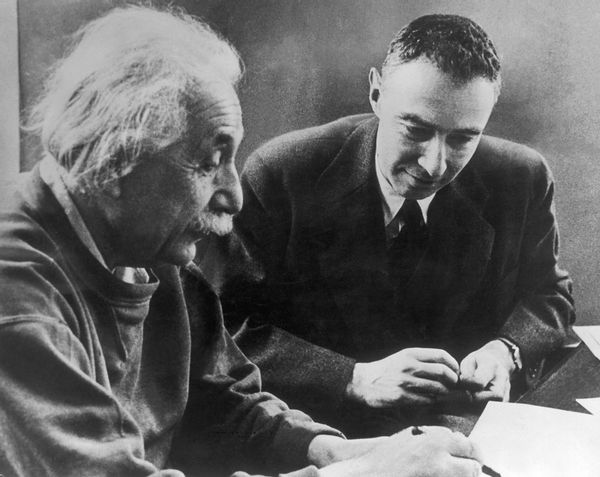
In Christopher Nolan's hit biopic "Oppenheimer," real-life Danish physicist Niels Bohr is more than just a major character. As depicted by Shakespearean actor Kenneth Branagh, he is a living legend, looming large both over the film's depiction of the Manhattan Project and over the psyche of the titular protagonist himself, J. Robert Oppenheimer. The film even includes a controversial scene in which Oppenheimer tries to poison his professor after being denied the right to attend a lecture being given by Bohr. (Experts on Oppenheimer strongly doubt this ever happened.)
There is a good reason why both the fictional and real Oppenheimer were so awed by Bohr. In real life, Bohr revolutionized the world of physics, and then went on to be a humanitarian as passionate and progressive as Oppenheimer himself.
Then again, also like Oppenheimer, Bohr's legacy is also colored because of his involvement in the Manhattan Project — and, by extension, all of the horrors wrought by the birth of nuclear weapons.
Yet for most of his life, Bohr's name would hardly have been linked to human rights violations such as the bombings of Hiroshima, Nagasaki and the Marshall Islands. When World War II broke out in 1939, the Nobel Prize-winning Bohr had already spent decades as one of the most famous scientists in the world. He had cracked the code of atomic structures, determining how atoms are modeled — electrons orbiting a nucleus of protons and neutrons — and helping create quantum theory in the process.
Along with the German theoretical physicist Werner Heisenberg and others, Bohr developed the field of quantum mechanics (which Heisenberg founded) and constructed a popular interpretation known as the complementarity or Copenhagen interpretation of quantum mechanics. Bohr's interpretation remained the dominant view until the 1960s, while quantum mechanics is still taught in physics classes — and was instrumental to the creation of nuclear physics.

Joas added, "Without relativity, no GPS. Without quantum theory, no lasers, no transistors, no computers, no smartphones. And without relativity and quantum mechanics, no atomic bombs."
That last event is, of course, the most controversial in both men's careers. Just as the film "Oppenheimer" is cagey about the exact nature of Bohr's role in the Manhattan Project, historians in real life aren't entirely clear on what exactly Bohr did at Los Alamos.
"He also participated in the Manhattan Project, although his exact role is not fully known," Joas explained. "We know that he visited Los Alamos three times for about three weeks each time, and that he participated in some technical discussions, for instance about the implosion mechanism for the initiator of one of the two types of bomb that were being built."
Regardless of his role, it is difficult to praise Bohr without acknowledging this mark on his legacy. Overall between 110,000 and 210,000 people died because of the atomic bombs that were dropped on Hiroshima and Nagasaki. Millions more have perished as a result of the Cold War which followed, some would argue inevitably. Yet very much like Oppenheimer before him, Bohr never joined the Manhattan Project with the idea that he was playing the role of a future villain. Quite to the contrary, he did so to try to stop one of the greatest destructive forces humanity has ever known.
Jim Ottaviani, author of a series of graphic novels about great scientists that includes "Suspended in Language: Niels Bohr's life, discoveries, and the century he shaped," offered a plausible explanation for why Bohr sided so strongly with the Allies. Although he was not a religious man, ethnically Bohr was half-Jewish (his mother came from a prominent Jewish banking family.) And as secular Jewish intellectuals like Sigmund Freud learned the hard way during the Holocaust, Nazis regarded Bohr as a Jew regardless of incidental details like how he happened to worship. If there was one thing Bohr knew, it was that Nazis are pure evil.
"I hate to say it this way, but [he would have been] a prize if he were captured" by the Germans, Ottaviani explained. "That would have been something that the Nazis probably would've been very happy about, and for good reason. He eventually did escape to the United States and did offer his expertise and services to the Manhattan Project. He was pretty well known and probably his relationship to many, many German physicists — most particularly Werner Heisenberg —brought him to the attention of people who probably wouldn't have paid much attention to physicists and scientists, otherwise."
Bohr did more than help the United States military best the Nazis. He also used his clout to come to the aid of the Jews of Denmark.
"The Bohr brothers helped by writing letters and arranging stays or even positions at the University, but also raised funds with private foundations to help support the refugees," Joas explained. "Unfortunately, most of the records of these activities have not survived, possibly because the German occupation of Denmark in 1940–1945 may have made it advisable to destroy documentation of who in Central Europe was helping scholars escape Nazi Germany. According to Bohr's biographer Abraham Pais, the documents were burned in 1940."
Perhaps Bohr's most dramatic moment occurred in late September and early October 1943, when Bohr met with Sweden's King Gustav V, the Swedish Crown Prince and other Swedish government officials to plead for humanitarian assistance for Danish Jews less fortunate than himself.
"Bohr proposed specific courses of action to the Swedish foreign minister and other senior officials in the ministry," Joas told Salon. "Historians debate the extent to which these interventions were crucial for Sweden's policy of accepting all Jews from Denmark into their country. They certainly did not hurt their cause."
After World War II ended, Bohr adopted a cause that Oppenheimer also embraced: World peace. Both men opposed nationalist impulses as irrational and dangerous, and instead supported a global system for regulating nuclear weapons and other technologies that posed an existential threat to the human species. In an open letter to the United Nations that he published in 1950, Bohr argued that there are "unique opportunities for furthering understanding and co-operation between nations which have been created by the revolution of human resources brought about by the advance of science."
On the one hand, he clearly relished the prospect of brilliant people working together to improve the quality of life for all individuals in a selfless enterprise. At the same time, he admitted that he and his fellow scientists recognized the darker implications of their work.

The solution, Bohr argued, was for the better impulses of human nature to win out.
"Indeed, it need hardly be stressed how fortunate in every respect it would be if, at the same time as the world will know of the formidable destructive power which has come into human hands, it could be told that the great scientific and technical advance has been helpful in creating a solid foundation for a future peaceful co-operation between nations," Bohr wrote.
"Bohr's 'Open Letter to the United Nations' has aged well and in my view is as relevant today as it was back then, if not more so, given the more complex balance of power in international politics and the much wider availability and greater destructive power of nuclear weapons," Joas wrote to Salon, later describing Bohr's ideas as "still the most important tool towards a safer world. In a world that is undergoing turbulent and dramatic changes on the international scene — which is as true today as it was in 1950, when Bohr wrote his letter—we urgently need actors who, in Bohr's spirit, stand up for a hopeful change in international relations, and actors who dare to talk to others, even across political and ideological divides."
Indeed, Bohr certainly practiced what he preached, with Joas noting that after World War II the physicist "was centrally involved in the discussions that led to the founding of CERN [European Organization for Nuclear Research], and was the key person in the founding of NORDITA, the Nordic Institute for Theoretical Atomic Physics, now located in Stockholm, and the Risø nuclear research facility in Denmark."
Ottaviani was more critical of Bohr's geopolitical philosophy.
"I think he was considered, to some extent like Oppenheimer, naive about where things were with the threat, real and perceived, of say the Soviet Union," Ottaviani told Salon. "He had an idealistic view of international cooperation, probably colored in large part by how cooperative the scientific community had been up until roughly that point, in terms of developing the theories and the basic ideas behind what turned out to be a horrible nuclear arms race. I don't think he was realistic about whether and how it would be possible to close Pandora's Box again."







